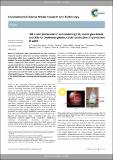Files in this item
‘All in one’ photo-reactor pod containing TiO2 coated glass beads and LEDs for continuous photocatalytic destruction of cyanotoxins in water
Item metadata
| dc.contributor.author | Gunaratne, Nimal | |
| dc.contributor.author | Pestana, Carlos | |
| dc.contributor.author | Skillen, Nathan | |
| dc.contributor.author | Hui, Jianing | |
| dc.contributor.author | Rajendran, Saravanan | |
| dc.contributor.author | Edwards, Christine | |
| dc.contributor.author | Irvine, John Thomas Sirr | |
| dc.contributor.author | Robertson, Peter | |
| dc.contributor.author | Lawton, Linda | |
| dc.date.accessioned | 2021-01-09T00:38:55Z | |
| dc.date.available | 2021-01-09T00:38:55Z | |
| dc.date.issued | 2020-04 | |
| dc.identifier | 267283387 | |
| dc.identifier | 1cace93b-8546-439c-ba52-d650536b50df | |
| dc.identifier | 85083090486 | |
| dc.identifier | 000525041900024 | |
| dc.identifier.citation | Gunaratne , N , Pestana , C , Skillen , N , Hui , J , Rajendran , S , Edwards , C , Irvine , J T S , Robertson , P & Lawton , L 2020 , ' ‘All in one’ photo-reactor pod containing TiO 2 coated glass beads and LEDs for continuous photocatalytic destruction of cyanotoxins in water ' , Environmental Science: Water Research & Technology , vol. 6 , no. 4 , pp. 945-950 . https://doi.org/10.1039/c9ew00711c | en |
| dc.identifier.issn | 2053-1400 | |
| dc.identifier.other | ORCID: /0000-0002-8394-3359/work/71954821 | |
| dc.identifier.uri | https://hdl.handle.net/10023/21252 | |
| dc.description | Authors wish to thank EPSRC Global Challenges program for providing the funding for this project (Grant number EP/P029280/1). NS wishes to thank ‘Energy Pioneering Research Program (PRP)’ at QUB. JTSI and JH wish to acknowledge EPSRC Capital for Great Technologies (Grant EP/LP017008/1and EP/R02375/1). | en |
| dc.description.abstract | Blooms of blue-green algae (cyanobacteria) in water reservoirs frequently produce highly toxic secondary metabolites including microcystins which have resulted in both human and animal fatalities. To tackle this global problem, we present here a viable solution: utilising the photo-catalytic power of TiO2 immobilised on glass beads that are encased in ‘photo-reactor pods’, equipped with UV LEDs, for the photocatalytic destruction of cyanotoxins. These reactor pods are designed in such a way that they can be used continuously with the aid of a power supply to facilitate the photocatalytic process. This process could be used to address one of the Global Challenges: providing safe drinking water around the globe. | |
| dc.format.extent | 5 | |
| dc.format.extent | 1095571 | |
| dc.language.iso | eng | |
| dc.relation.ispartof | Environmental Science: Water Research & Technology | en |
| dc.subject | QD Chemistry | en |
| dc.subject | DAS | en |
| dc.subject | SDG 6 - Clean Water and Sanitation | en |
| dc.subject.lcc | QD | en |
| dc.title | ‘All in one’ photo-reactor pod containing TiO2 coated glass beads and LEDs for continuous photocatalytic destruction of cyanotoxins in water | en |
| dc.type | Journal article | en |
| dc.contributor.sponsor | EPSRC | en |
| dc.contributor.sponsor | EPSRC | en |
| dc.contributor.institution | University of St Andrews. School of Chemistry | en |
| dc.contributor.institution | University of St Andrews. Centre for Designer Quantum Materials | en |
| dc.contributor.institution | University of St Andrews. EaSTCHEM | en |
| dc.identifier.doi | https://doi.org/10.1039/c9ew00711c | |
| dc.description.status | Peer reviewed | en |
| dc.date.embargoedUntil | 2021-01-09 | |
| dc.identifier.grantnumber | EP/P029280/1 | en |
| dc.identifier.grantnumber | EP/R023751/1 | en |
This item appears in the following Collection(s)
Items in the St Andrews Research Repository are protected by copyright, with all rights reserved, unless otherwise indicated.

